White rock landscaping ideas are becoming a favorite among homeowners seeking a low-maintenance yet visually stunning yard. Whether you’re upgrading your front yard landscaping or curating a serene backyard retreat, white rocks like marble chips and river stones deliver a timeless, clean aesthetic that elevates nearly any outdoor space. Their brightness adds striking contrast to greenery, effortlessly defines zones, and addresses practical concerns like drainage and weed suppression.
From modern borders to rustic landscaping with rocks, and even whimsical dry riverbeds, incorporating white rocks into your layout can transform the overall feel of your garden—all while keeping your maintenance schedule blissfully light.
🌿 Love gardening inspiration? Follow me on Pinterest for bold plant ideas, tips, and seasonal color!
Table of Contents
1. Elevate Backyard Golf with White Marble Rocks Border
Incorporating a golf feature in your backyard? Bordering your putting green with white marble rocks not only defines the play area but also protects the turf and adds a polished look. These smooth, reflective stones create a striking boundary that contrasts beautifully with vibrant green grass, giving your mini-golf zone a professional feel.
They’re also practical—keeping stray golf balls from rolling into garden beds or muddy patches. Use medium to large white marble rocks to create a visual edge that feels intentional and refined. For a seamless look, match the rock size to your turf elevation and edge width.
Tip: Use landscape fabric beneath the rocks to prevent weeds and maintain a clean edge.
2. Create a Rustic Pathway with River Rocks
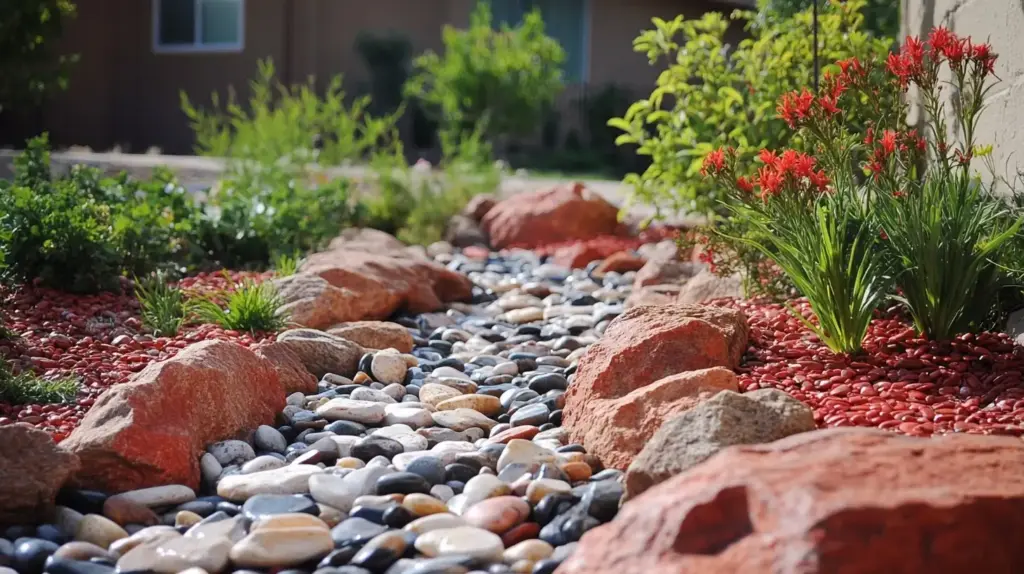
Designing a garden path with white river rocks brings a natural, rustic charm to your outdoor space while staying low-maintenance and visually appealing. Their rounded edges make them ideal for walkways, blending seamlessly with the soil and surrounding elements.
To build a pathway that complements a cottage-style or woodland garden, layer white river rocks over compacted soil or gravel for stability. Surround the path with rust-colored mulch or native grasses to add contrast and texture.
This style is especially useful for xeriscaping or managing water runoff on uneven terrain. River rocks allow water to pass through while minimizing erosion—an elegant and eco-conscious solution.
Bonus Idea: Border your path with reclaimed wood or stone edging for added definition and rustic flair.
3. Modern Look with White River Rocks and Black Mulch
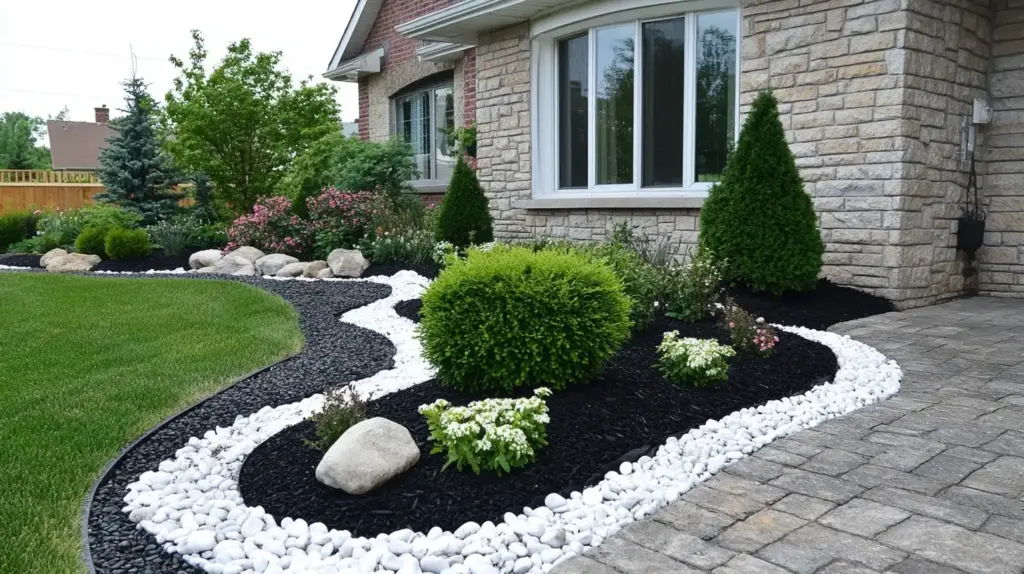
For a bold, contemporary contrast, pair white river rocks with deep black mulch. This modern landscape combo works especially well with minimalist or geometric garden designs, where clean lines and stark color separation are key.
Use black mulch around shrubs or hedges to suppress weeds and retain soil moisture, then frame each section with smooth white river rocks. This design technique enhances structure and brings out the rich tones of nearby foliage, especially in front yards with red brick or modern architecture.
To elevate the look, space out ornamental grasses or sculptural plants like boxwoods, letting the white stones create a gallery-like setting around each planting.
Design Tip: Stick to symmetrical layouts and repeating shapes to fully embrace the modern aesthetic.
4. Transform a Tricky Area into an Inviting Focal Point
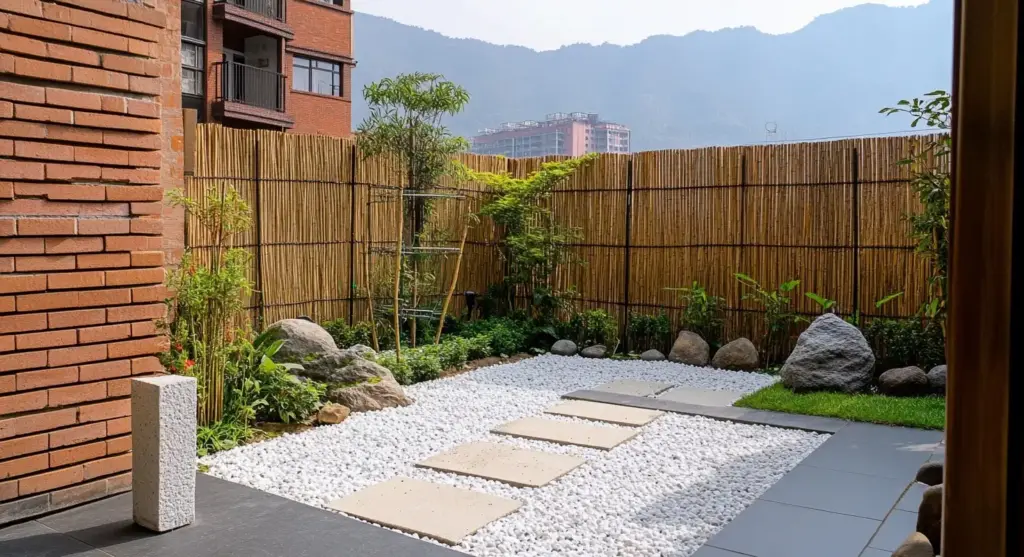
Have an awkward slope or unused corner in your yard? White rock landscaping ideas can turn problem spots into standout features with minimal effort. Sloped areas near retaining walls or poorly draining corners often resist traditional planting—this is where white rocks shine.
By layering white marble chips or river rocks in these tough zones, you can stabilize the soil, reduce erosion, and instantly create visual interest. Add a few drought-tolerant plants like sedum, ornamental grasses, or succulents to soften the look and bring life to the area.
You can also use large stones or driftwood pieces to play with scale and shadows, turning a neglected space into a serene, decorative focal point.
Tip: Use lighting to accentuate textures and bring nighttime charm to the feature.
5. Enhance Outdoor Aesthetics with White Marble Chips
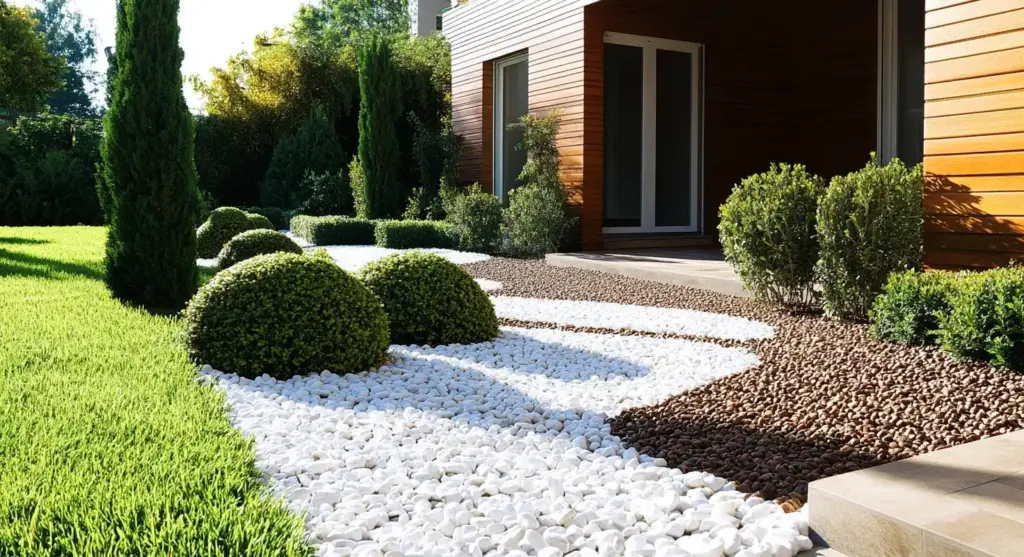
White marble chips are a favorite for homeowners looking to elevate curb appeal with elegance and simplicity. Their crisp, clean appearance creates stunning contrast against lush greenery, flower beds, and structural elements like walkways and patios.
Use marble chips to line paths along the side of your home or around foundation plantings. The reflective quality of the stone brightens dim areas and highlights plant groupings without overwhelming them. These chips also help retain moisture and reduce weed growth, making your landscape not only beautiful but practical.
To avoid mess and keep lines tidy, install metal or plastic edging to contain the chips and prevent migration into lawns or other beds.
Maintenance Tip: Rinse marble chips occasionally to keep their white hue vibrant and free from dust or debris.
6. Balance Shape of Plants with White Marble Chips
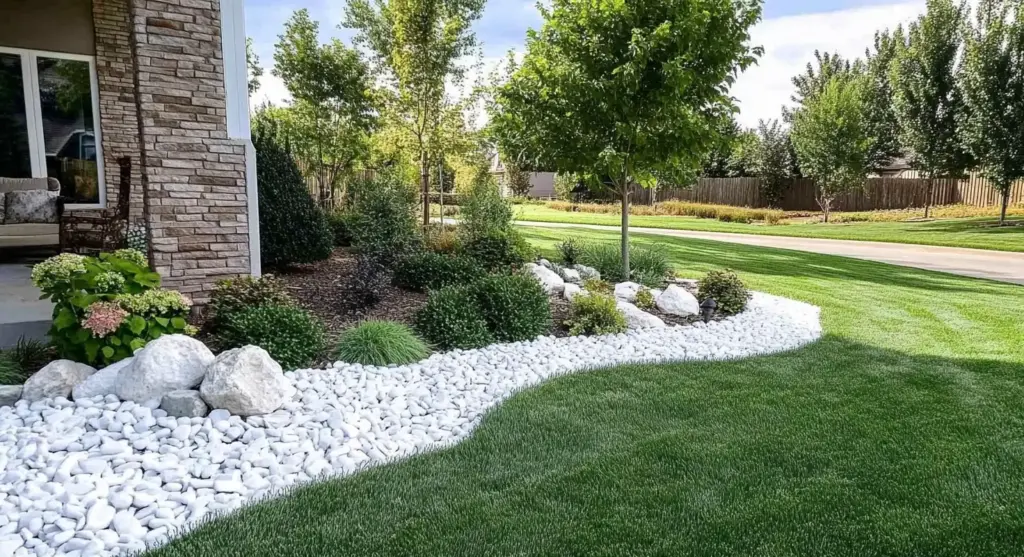
One of the most underrated white rock landscaping ideas is using marble chips to highlight plant shapes and spacing. When plants are surrounded by dark soil or mulch, their form can disappear into the background. White marble chips, however, act like a visual spotlight, making each plant stand out clearly.
This is especially effective with sculpted shrubs, ornamental grasses, or small perennials. The bright stones enhance contrast, helping the eye follow garden contours and patterns with ease. You can also integrate larger boulders to balance negative space and add depth.
Plus, marble chips help hide practical elements like irrigation hoses or spotlight cords, keeping your garden looking polished and organized.
Pro Tip: Keep marble chips away from plant stems by a few inches to ensure healthy airflow and prevent rot.
7. Boost Your Curb Appeal with Rock Gardening

If you want a low-maintenance yet striking front yard, rock gardening with white stones is a powerful solution. Combining different rock shapes and sizes—like white marble chips, river rocks, and boulders—creates depth and texture, even in spaces with minimal planting.
By strategically placing rocks around key elements such as trees, mailboxes, or walkways, you can define zones and reduce lawn area, cutting down on upkeep. White rocks in particular brighten shady spots and make even small patches of green pop.
This style works beautifully for water-wise landscaping and is ideal for dry climates or homes with minimal rainfall.
Design Tip: Add a few sculptural plants like agave or yucca among the rocks for architectural interest and height variation.
8. Be Creative with a Spilling Pot River Rocks Garden
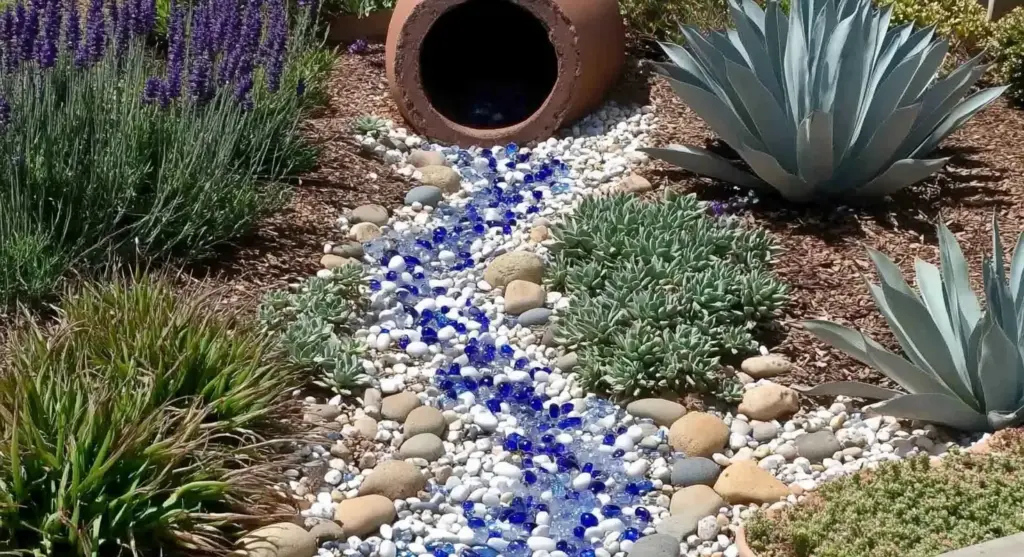
A whimsical and artistic use of white rock landscaping ideas is creating a “spilling pot” feature using white river rocks. This playful design gives the illusion that stones are pouring out of a tipped-over terracotta or ceramic pot and flowing across the garden like a dry riverbed.
To build it, partially bury a large pot at an angle, then arrange white river rocks in a natural, curved path extending from the mouth of the pot. You can mix in a few contrasting stones—like black lava rock or soft gray pebbles—for added visual interest.
Surround the design with low plants or small garden ornaments to bring character and cohesion to the scene.
Creative Tip: Switch out seasonal flowers in pots behind the “spill” to update the look year-round.
9. Beautiful Riverbed with White Rocks and Blue Pebbles
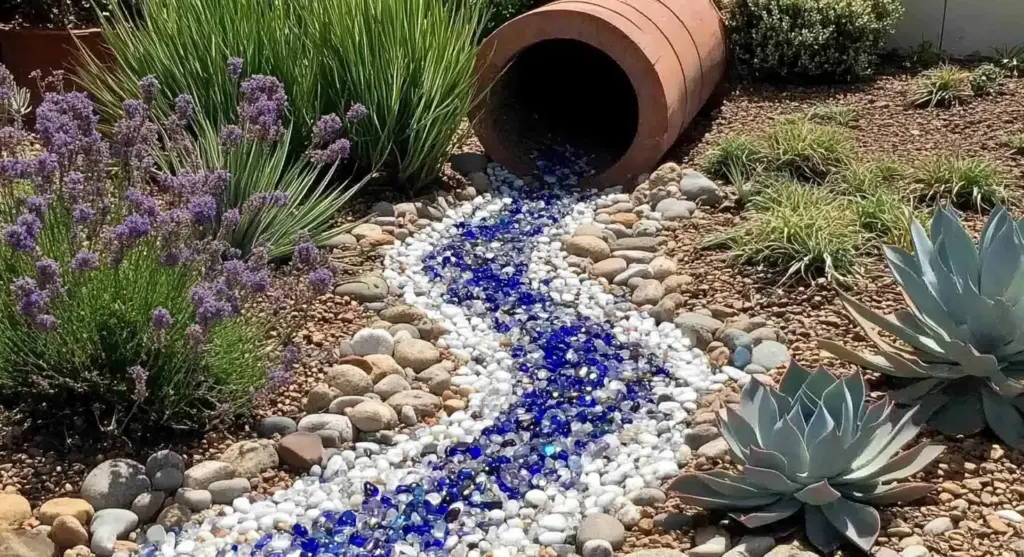
Transform your yard into a tranquil retreat by designing a dry riverbed with white rocks and blue pebbles. This approach mimics the flow of water using stone, creating a visually soothing feature that requires no irrigation or drainage system.
Start by mapping a gentle, winding path where the “river” will run. Use white river rocks or marble chips as the base to mimic clear, shallow water. Then, scatter blue glass pebbles or polished stones to add color and create the illusion of depth. Add a few large rocks or driftwood pieces to simulate natural debris found in real streams.
This design not only adds beauty but also helps manage rainwater runoff on sloped yards or near downspouts.
Design Note: Plant succulents or ornamental grasses along the edges to give the riverbed a natural shoreline effect.
10. Create Balance and Beauty with Mulch and Marble Chips
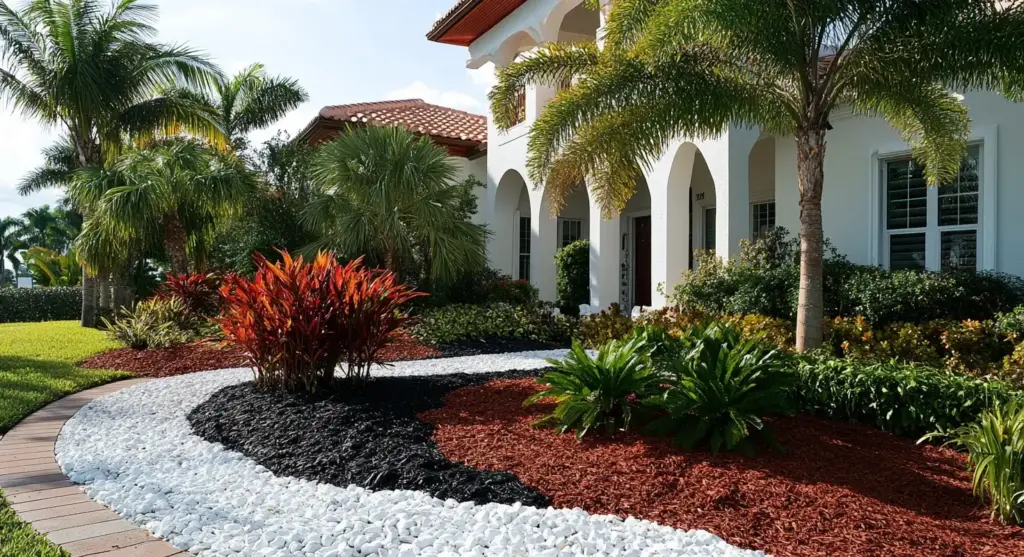
Combining organic mulch with white marble chips is a smart way to bring harmony, texture, and functionality to your garden beds. While mulch nourishes the soil and helps retain moisture, marble chips offer contrast, structure, and visual clarity.
Use reddish-brown or black mulch in planting zones and define their boundaries with curved or geometric edges of white marble chips. This not only enhances visual interest but also creates a symbolic balance—warm, earthy tones alongside cool, crisp whites.
Consider using this design around trees, where the pattern can change as the tree matures, allowing for flexible layout updates. Grouped plantings like snake plants or hostas look especially striking against this dual-toned background.
Practical Tip: Keep marble chips at least a few inches from tree trunks to avoid root suffocation and pest issues.
11. Enchanted Paradise with Marble Chips and Brown Pebble

Turn a small garden bed into an eye-catching feature by blending white marble chips with warm-toned brown pebbles. This contrast adds a natural elegance that feels both curated and relaxed—perfect for creating an “enchanted” garden corner.
Start by defining the bed’s shape with edging or low stone borders. Fill the central area with marble chips to brighten and highlight focal points, such as a flowering plant, sculpture, or dwarf tree. Surround it with brown pebbles to add warmth and soften the look. The two textures and tones play off each other beautifully, enhancing depth and dimension.
This layered design works especially well in compact spaces or courtyard gardens where every detail matters.
Bonus Idea: Add solar-powered garden lights for a magical evening glow among the rocks.
12. Make Your Hedges Stand Out with Large River Rocks
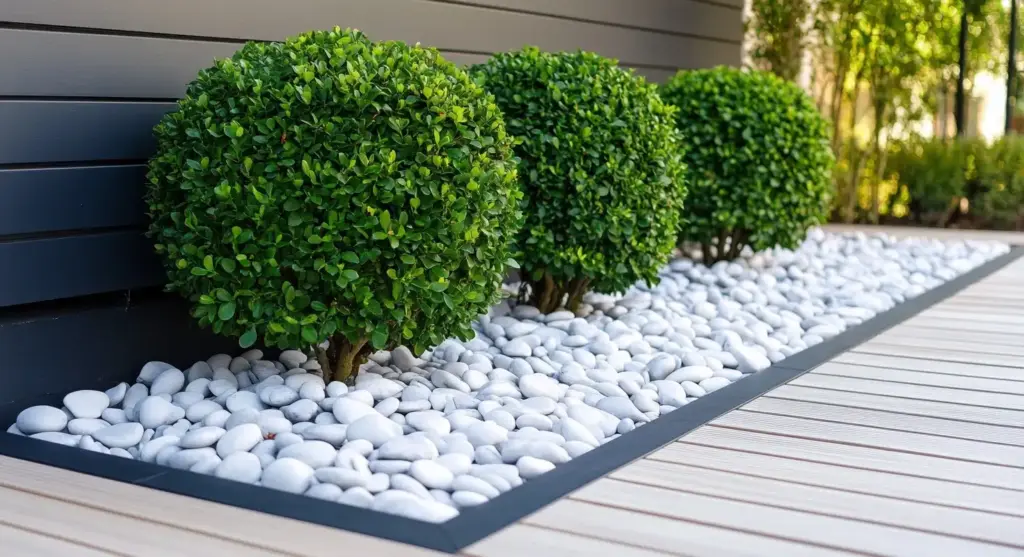
Hedges can blend into the background if not framed properly, but surrounding them with large white river rocks gives them a clean, defined edge and a polished, intentional look. These larger stones create visual weight at the base, helping hedges appear more structured and manicured.
Place the river rocks in a wide band around the base of each hedge row, ideally over a weed barrier fabric to keep maintenance low. The white color contrasts beautifully with deep green foliage and dark mulch, drawing attention to the hedge line and brightening the space.
This method also prevents mulch from spilling onto nearby hardscapes and helps with water drainage near patio edges or foundations.
Pro Tip: Use rocks that are at least 3–5 inches in diameter for the best visual impact and stability.
Conclusion
Whether you’re designing a sleek modern front yard landscape or adding character to a rustic rock garden, white rock landscaping ideas offer both versatility and visual impact to elevate any outdoor setting. From defined borders and dry riverbeds to creative spilling pot arrangements, white rocks go beyond aesthetics—they simplify upkeep, manage water flow, and spotlight your favorite plants like no other material can.
With intentional placement and a little creativity, your garden can become a reflection of your unique style—whether you’re maximizing curb appeal or shaping a relaxing backyard escape. Let these ideas guide you in building a space that feels like home—and makes a lasting impression.
FAQ
What are the benefits of using white rocks in landscaping?
White rocks offer a clean, modern aesthetic that enhances contrast with plants and other materials. They help suppress weeds, improve drainage, and require minimal maintenance compared to mulch or grass.
Do white landscaping rocks get dirty easily?
Yes, white rocks can collect dust, dirt, or organic debris over time. However, they’re easy to clean—simply rinse with a hose or soak and scrub stubborn spots. Using landscape fabric underneath also reduces buildup from below.
Can I mix white rocks with mulch?
Absolutely. Combining white rock landscaping ideas with mulch adds texture, color contrast, and structure to your garden beds. Use mulch for moisture retention and nutrients, while white rocks define spaces and reduce mess.
Are white marble chips safe for plants?
Yes, but make sure not to pile them too close to stems or trunks. Leave a few inches of space for airflow and to avoid root rot. Marble chips also reflect light, which can benefit sun-loving plants.
How do I keep white rocks in place?
Install landscape edging or steel borders to prevent rocks from spreading into lawns or walkways. You can also use a compacted base layer (like crushed gravel) to stabilize the surface underneath.
Is white rock landscaping expensive?
White rocks, especially marble chips, can be pricier than mulch upfront. However, their durability and minimal maintenance often make them more cost-effective in the long run.

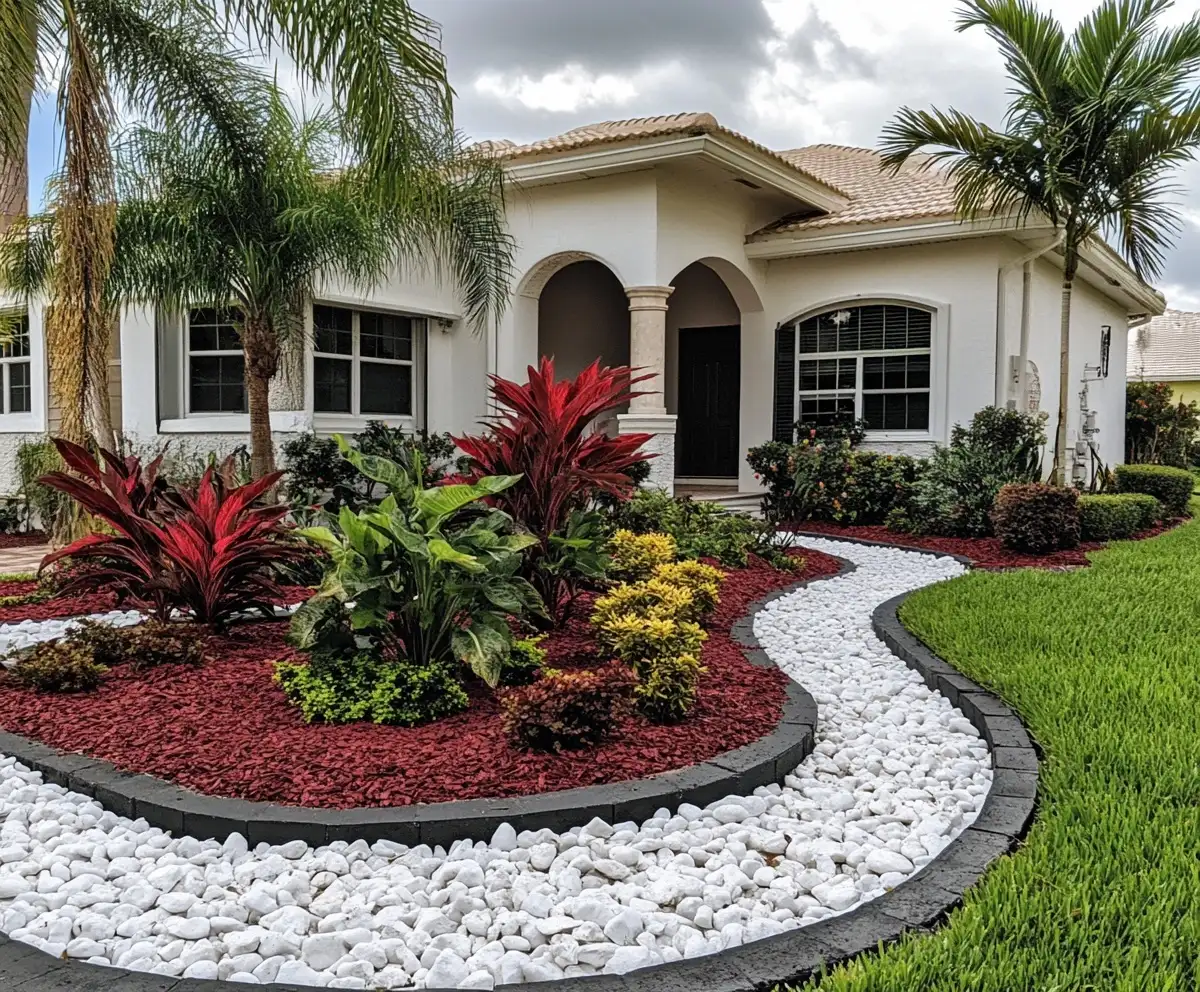
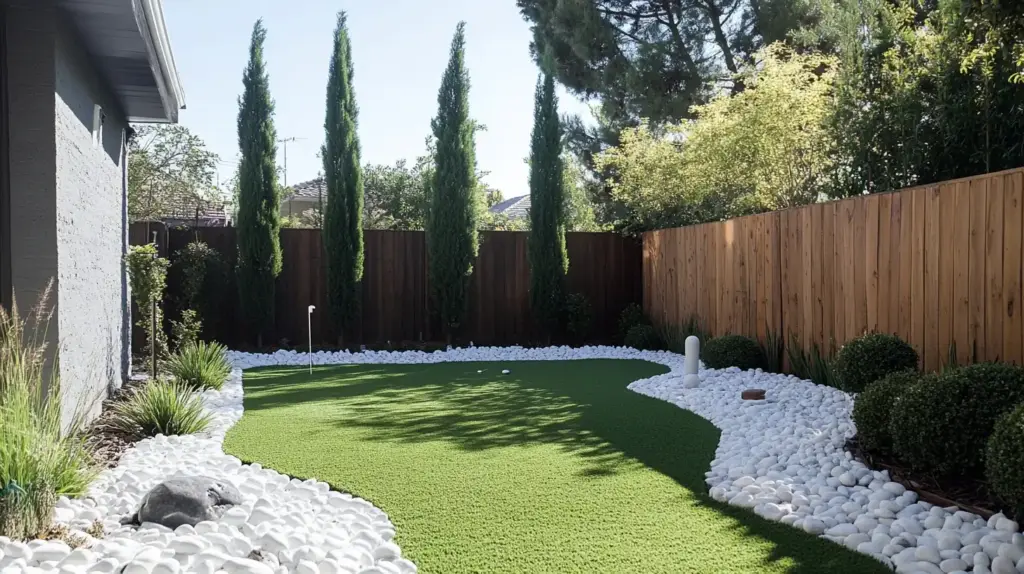
White rock is not maintenance free. First year or three it’s gorgeous. However after a few years the blowing seeds will land in the rocks. They sprout – and sprout constantly because the rock is like a heat pad and the fabric holds moisture. Bad news, you are not going to enjoy moving tons if rock or pulling weeds. Good news – I’ve gotten multiple years from annuals because that rock is hot. And there is a chemical that stops the sprouting. It doesn’t hurt your flowers and plants but will keep sprouts to a minimum IF you get it down before they start. PreEmergent -pricey but worth it.